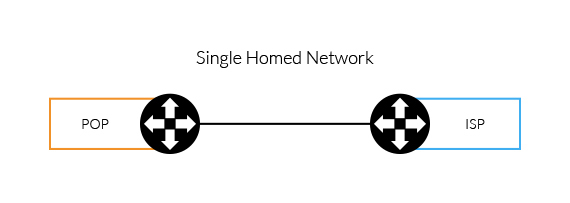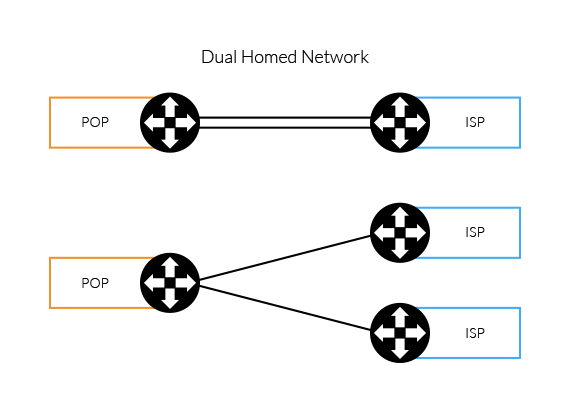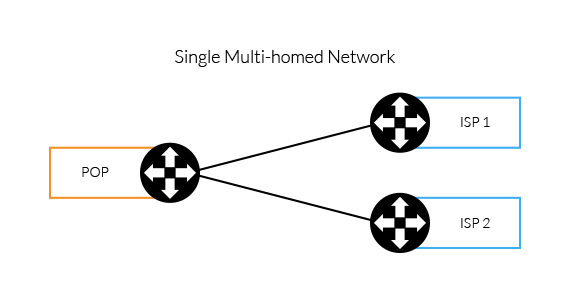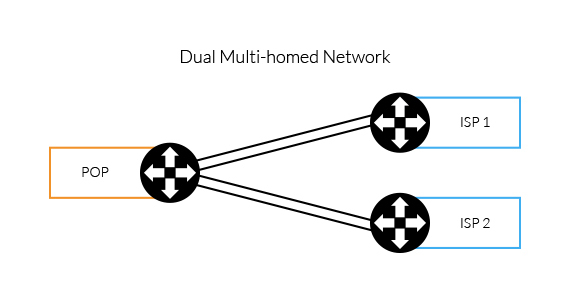You will often come across the terms Single Homed, Dual Homed, and Single/Dual multi-homed when talking about the ISP/BGP connections in a data center. These terms are nothing but design topologies used to distinguish how the POP is connected to one or multiple ISPs. Each of these topologies are different from the other and serves different purposes and must be chosen as per the requirement.
Let us know explore what are these ISP connections are and how they function. There are three types of homed networks, although the terms single-homed and multi-homed are the most commonly used.
When a site (POP) establishes a connection with just one single ISP then the connection is called Single-Homed Network. Under this topology, the set-up uses a static/dynamic routes provided by the ISP which is then connected to the edge router of the POP.
The following graphical representation of this topology will give you a clear insight on how the connection is established

The only advantage of this type of setup is that it is highly cost effective. However, it is not safe as it does not provide any redundancy or backup. Any breakage in the link will cause disruption in the whole connection. This is fine for a site that does not depend heavily on Internet.
In a Dual-Homed Network connection, a site has two or more connection to the same ISP. Now this can be connected to either one or two edge routers (ISP or POP) where one link is primary and the other is secondary or backup. The other way a POP can use this topology is to load balance the traffic using both the links. This type of network also offers redundancy at the host side.
Let's see how this connection looks like

Multi-Homed Network connection is when the POP is connected to more than one ISP at the same time. This type of Network topology offer several benefits including redundancy and backup in case of failure (any one ISP). In such scenario where one of the ISP goes down, the system switches all the traffic to the other active ISP without any network downtime. Another huge benefit is that the POP can decide the best network path to route the traffic and offering high efficiency. One can take Multi-Homing a step further and offer Dual-Multihomed, where there are two connections to multiple ISPs. This topology offers the most redundancy.
Single Multi-Homed Network connection

Dual Multi-Homed Network Connection

Why Multi-Homed Network is so essential in today's world?
In comparison to Single and Dual Homed Network, a Multi-Homed offers much more features and advantages that can benefit a host as well as the client. Redundancy/Reliability and Performance are the two major factors a client looks for before choosing a service provider. Having Multi-Homed network offers high level of both Efficiency and Reliability for business. Therefore, to maintain the same level of network quality worldwide a host must partner with multiple carriers.
Multi-Homing at Psychz Networks
Psychz Networks is truly a Multi-Homed Network offering seamless service to our clients 24/7. We have a fault tolerant network with redundancies at every level. We have multiple upstream connections to internet offering services from some of the leaving service providers from across the globe including Hurricane, China Unicom, Nlayer, Tinet, NTT, Comcast, PCCW and more. And because we’re a multi-homed network provider with all of these redundancies in place we are able to offer our customers the ability to choose from the providers they like or from the one that can meet their requirement. To learn more about our network please visit https://www.psychz.net/network.html